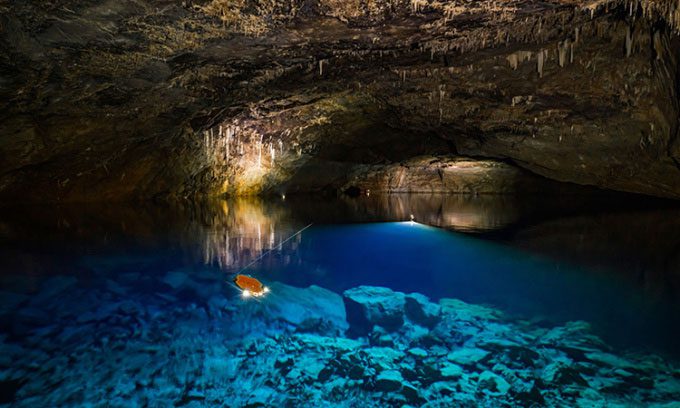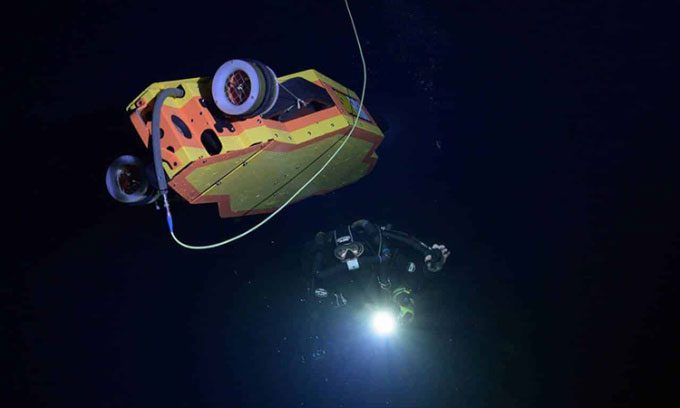The Dragon’s Breath cave, covering about 2 hectares and reaching depths of over 200 meters, contains a crystal-clear underground lake that is home to living organisms.
Deep below Namibia lies a flooded cave known as Dragon’s Breath, which conceals the largest subterranean lake not located beneath ice on Earth. For decades, the world remained unaware of the true size of this body of water because explorers could only dive to limited depths. However, technological advancements have gradually unveiled the cave’s secrets.

The Sunfish autonomous submersible mapping part of the underground lake in Dragon’s Breath cave. (Photo: United States Deep Caving Team/Kasia Biernacka).
Surveys conducted with robots in recent years have revealed that the Dragon’s Breath cave is over 200 meters deep. While it is difficult to provide an accurate figure for the total area of the lake, many experts estimate it to span approximately 2 hectares, surpassing the Lost Sea, the largest underground lake not beneath ice in the United States and the second largest in the world, which covers an estimated area of 1.8 hectares.
Namibia is a coastal country located in southern Africa, characterized by its arid yet stunning landscapes. The name Namibia is derived from the local term “Namib,” meaning a vast and empty place. This African nation boasts at least 124 caves, a significant number of which are located in the Otjozondjupa region, including the Dragon’s Breath cave.
The cave’s name is believed to originate from the warm, humid air that “welcomes” explorers at the entrance. Once inside, most parts of the cave are nearly devoid of light. The lake’s water is crystal clear, and surprisingly, it still hosts life in the form of worm-like creatures and small shrimp.
According to a documentary about Africa by renowned British naturalist David Attenborough on BBC, Dragon’s Breath cave is home to the golden catfish (Clarias cavernicola), a unique-looking species from the catfish family that is classified as critically endangered in the International Union for Conservation of Nature (IUCN) Red List. However, other experts suggest that this species actually resides in a similar cave in Namibia—Aigamas cave.

The Sunfish submersible and a diver exploring the Dragon’s Breath cave. (Photo: United States Deep Caving Team/Jason Gulley).
Today, humanity still does not fully understand the biodiversity within the Dragon’s Breath cave due to the limited biological studies conducted on it. The first recorded explorations took place in the 1980s. According to the book “The Darkness Beckons” by explorer and diver Martyn Farr, one of the initial attempts was made by a group of divers and cavers from the South African Caving Association in 1986.
Some estimates from that time suggested that the underground lake was at least 150 meters deep. However, in 2019, an exploration team from the American company Stone Aerospace used the Sunfish submersible to demonstrate that the lake is much deeper. They found that the water surface was approximately 59 meters from the cave’s entrance and extended to a depth of 264 meters, meaning the total depth of the lake exceeds 200 meters.
The mini-submersible ventured deep into the cave, using lasers and sonar to map the area. In addition to revealing a large chamber near the entrance, the study showed that the cave has a shape resembling a pointed shoe.


















































